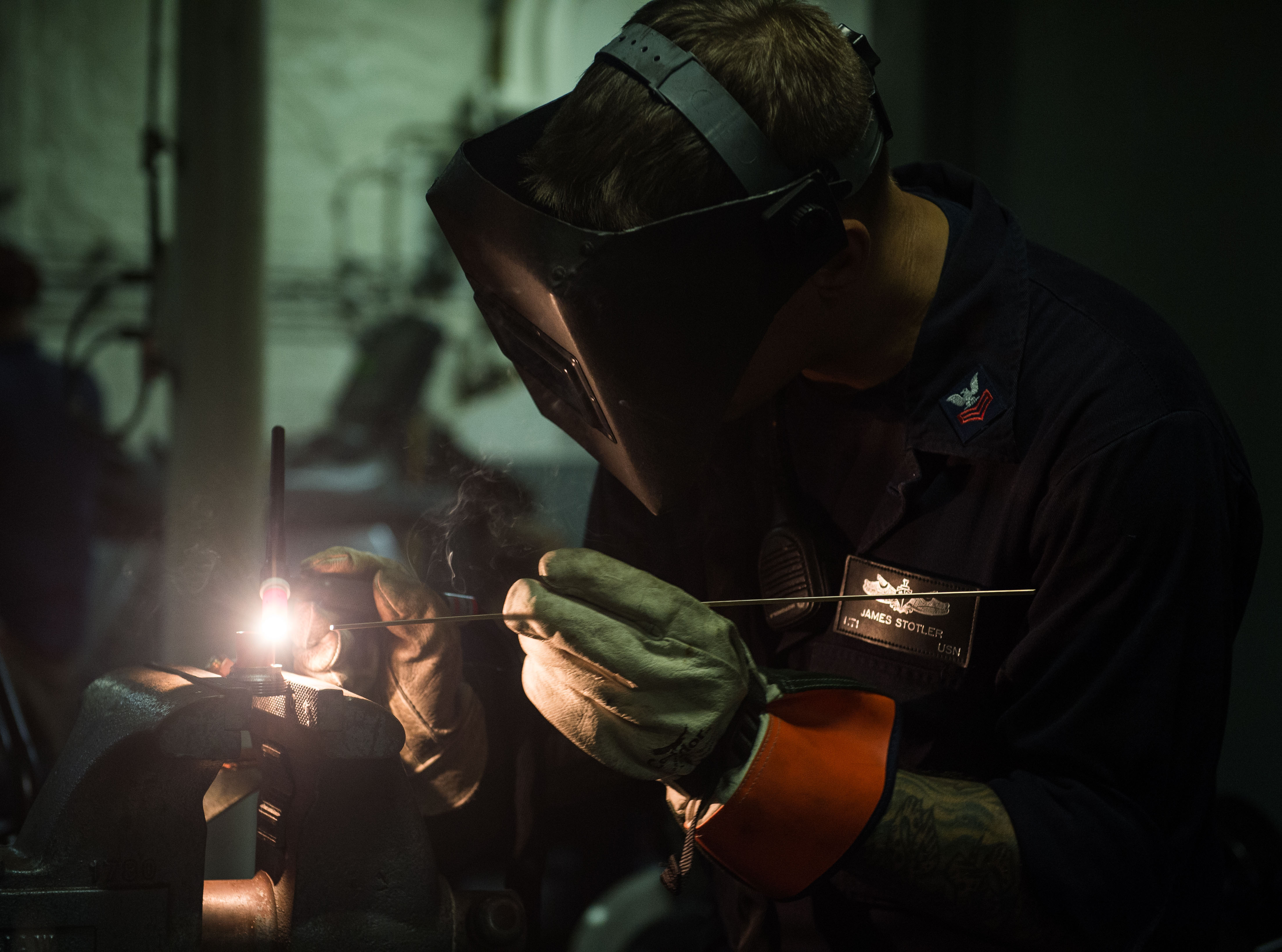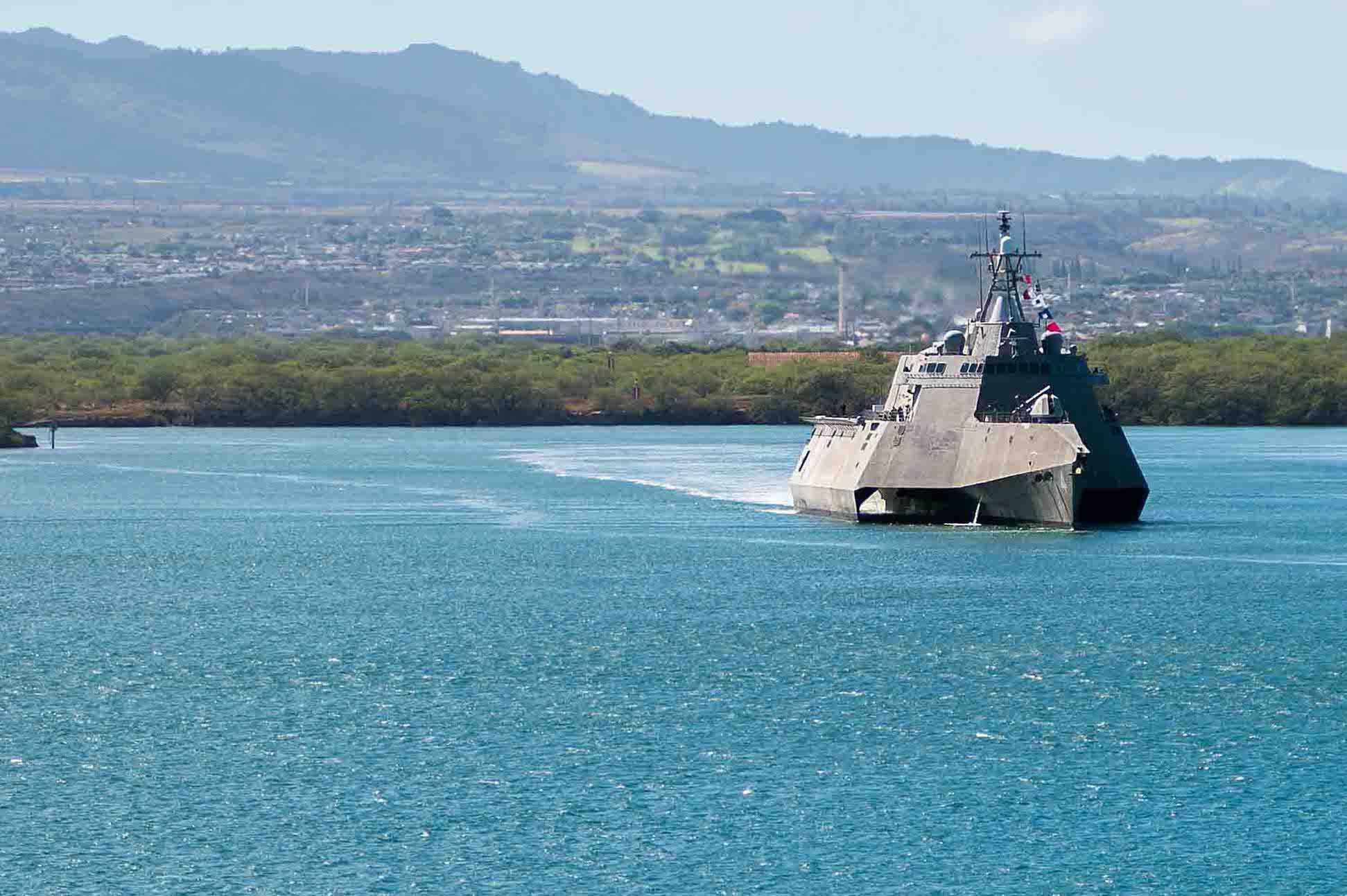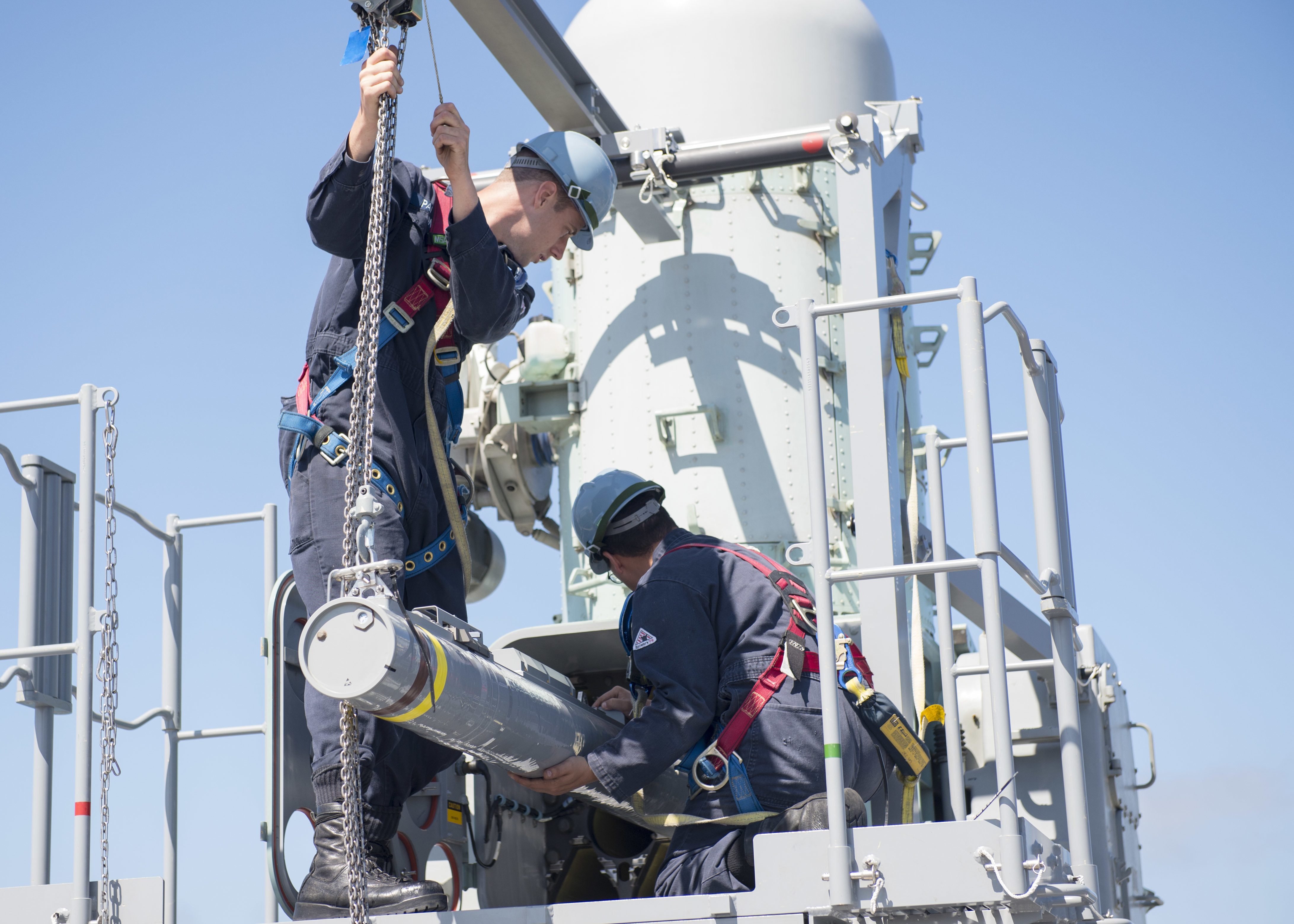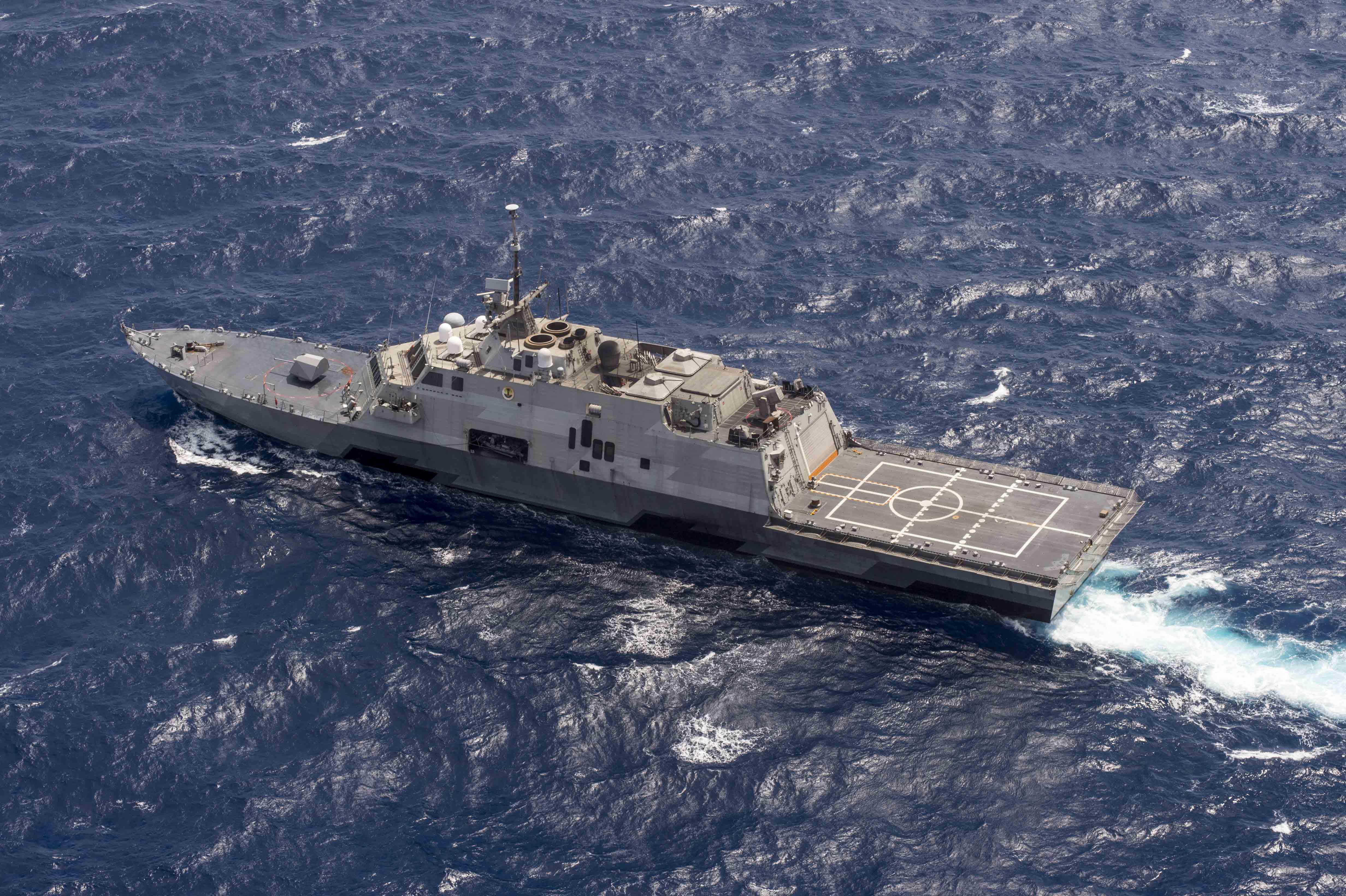
This article is the third in a three-part series on the changes occurring in the Littoral Combat Ship community as the fleet rapidly grows, moves to a new crewing and organizational construct and prepares for multi-ship forward operations.
SAN DIEGO – The Littoral Combat Ship community is taking steps to both decrease the amount of overall maintenance work the ships require and increase the percentage conducted by sailors instead of contractors, several officers told USNI News during a recent visit to the San Diego waterfront.
After last year’s LCS Review that ultimately called on the Navy to increase simplicity, stability and ownership within the LCS program, sailor-led maintenance is being looked at as a major way to boost ownership.
Though only a year into the implementation of the LCS Review recommendations – and ahead of funding that’s been requested to pay for the needed changes to the LCS program – some changes in LCS maintenance have already taken place on the waterfront.
LCS was originally envisioned to have a minimally manned crew that would conduct maintenance checks required more than once a month, with a contractor-led planned maintenance availability (PMAV) taking place about once a month and a longer continuous maintenance availability (CMAV) as needed for corrective and more intensive maintenance actions.
Now, Capt. Tom Workman, LCS Implementation Team leader, told USNI News from his office at Naval Amphibious Base Coronado, “we have a certain amount of maintenance that’s in sailor hands, we have a certain amount of maintenance that’s in contractor hands, and over the life of the program we’d like to get more of that into sailor hands and less of it in contract hands,” he said.
“That not only decreases cost but it increases ownership.”

The LCS fleet has moved to a new organization: an LCS Squadron – LCSRON 1 in San Diego and LCSRON 2 in Mayport, Fla. – will oversee several divisions of LCS ships, and in addition to the ships’ core crews taking over some more of the routine maintenance, the LCSRONs will also have maintenance execution teams “dedicated to be able to provide a greater manpower base to start absorbing some more of that contractor maintenance,” Workman explained.
At the same time, the fleet is learning more about what it takes to keep the ships ready to operate forward, through forward operations out of Singapore by USS Freedom (LCS-1), USS Fort Worth (LCS-3) and USS Coronado (LCS-4). The first four ships in the class are somewhat different than hulls 5 and beyond, but Workman said the fleet would be looking to learn from the 2018 deployments – expected to include at least USS Detroit (LCS-7) and USS Montgomery (LCS-8) – to help find more efficient ways to conduct maintenance on those later ships, with an eye towards reducing the man hours it takes to keep the ships ready while forward deployed. The hope is that PMAVs can be shortened, or they can be scheduled farther apart, Workman said – “any of that that we can do contributes to more operational availability forward, which was and is the number-one objective.”
If successful, then, the Navy would be both conducting less maintenance on the ships and allowing the sailors to perform a greater portion of that work.
Bits of that vision are already taking place in San Diego. Cmdr. Emily Cathey, commanding of USS Independence (LCS-2), said the first sailor-led PMAV took place in March in the ship’s San Diego homeport. She credited the LCSRON-1 team with helping pave the way for that and other changes to LCS maintenance – for every preventative maintenance procedure she hopes to incorporate into her crew’s list of responsibilities, the LCSRON needs to ensure the crew has the right equipment, the right people and the right written procedures to accurately and successfully perform that work.

As part of the LCS Review implementation, the LCS community moved from each ship having a core crew and a mission package detachment – for mine countermeasures, surface warfare or anti-submarine warfare – to a single crew. Cathey said her crew and MCM detachment fused together a few months ago, bringing her from a pool of 53 people who could perform ship maintenance to now 70. The former MCM detachment personnel are now fully integrated with the crew, standing watches, working in the engineering department and more to contribute to the material readiness of the ship. On Freedom, sitting at a nearby pier on the San Diego waterfront, two anti-submarine warfare detachments formally joined the crew last month, giving Commanding Officer Cmdr. Michel Falzone 73 crew members to share in the maintenance work, up from the 53 before.
LCSRON-1 Commodore Capt. Jordy Harrison told USNI News while aboard Independence that there’s a great misconception, even among sailors, about the maintenance work LCS crews conduct. He noted that every time the LCS launches a helicopter, small boats or unmanned vehicles, a slew of maintenance checks have to be conducted.
“All of those checks that are in the regular routine operations of the ship are what the ship crew does naturally when they’re out to sea, which is why we end up in the neighborhood of somewhere in the 14,000 man hours a year” conducted by the LCS crews, Harrison said.
“It was really about the monthly level and below checks are kind of within the capacity and the capabilities of the crew. And then those checks that went beyond the monthly scope usually were more intrusive and demanded more man hours – not always the case, but typically – and those were, in many cases, planned for those to be contractor-executed checks, because if you were doing them quarterly you could probably schedule them in conjunction with periods of time when the ship would be in port.”
Harrison that as the fleet operates the ships more, crews will find more efficient ways to schedule maintenance work, trimming down on the number of hours required to do maintenance. The way to make a real dent in total maintenance, though, would be to fully implement the conditions-based maintenance model the LCSs were built to support, he said.
The commodore noted that Independence, for example, was equipped with more than 7,000 sensors that send data off the ship on the status of various shipboard systems. Using that data to make decisions about when to perform maintenance – rather than just doing a daily, weekly or monthly check because a manual says so – would be the most efficient use of the small crew’s time.

“We’re going to use Fort Worth (LCS-3) … and conduct a very extensive conditions-based engineering reliability maintenance examination. The Navy, certainly the surface navy, in many cases by default, has done a very heavy reliance on time-based maintenance – so it’s monthly, time to change the oil, and we would do that. Well, that certainly is preventive, but is it the most cost-effective, most efficient and most effective way to do maintenance?” Harrison said.
“So we’re going to take a fulsome swing at, are there ways we can certainly be more effective and efficient? When you have an optimally manned or minimally manned crew, you need to be effective with that time because you want to make sure you’re doing the right maintenance. If you just say, time-based, you’ve got to do all this, you might have to make some risk decisions on which maintenance to do, but it might not be the right maintenance to do and the right maintenance to forego. If you had sensors and systems and the ability to say, hey, this piece of equipment is more at risk – so do I go do the change oil on my port diesel engine or change the oil on my starboard diesel engine? If we had the metrics and the analytical rigor that would say we might be getting ready to experience a casualty on your port engine, then we would say, I’ll wait to do the starboard and I’ll go do the port engine. So that’s sort of the thought process behind the conditions-based maintenance instead of the time-based maintenance. Where you are constrained with man hours with a smaller crew, you sometimes have to make those decisions, so we’re no kidding taking a look at how we can use the analytical rigor to help drive us into making the right maintenance decisions. And then what that may allow us to do as well is examine do we have the right crew complement, numbers and by ratings, designators, skillsets. Do we have the right total numbers, and do we have the right skillsets?”
Workman too said that condition-based maintenance would not only ease demands on the sailors but would also boost operational availability of the ships to the forward operational commander, since maintenance periods could be shorter and the ships would then spend more time at sea. He said the LCS has more sensors than any other warship in the fleet, which should be leveraged to let the equipment tell sailors when a preventative check or corrective maintenance action needed to be performed.





